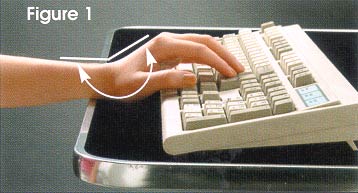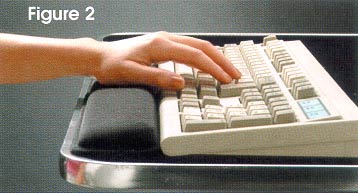Strategies for Correct Usage of Palm
Supports and Wrist Rests
What is a Wrist Rest or Palm Support?
A Wrist Rest or Palm Support is a object
with padding (foam, gel, etc.) which can be placed on a
hard surface to soften a firm surface. It can also
provide support, increasing the elevation from the
worksurface if the current height of the worksurface is
too low.
What is the Difference Between a Wrist Rest
and a Palm Support?
The primary distinction is usage. A
Wrist Rest is a device that one rests their wrist upon,
i.e. the area below the palms of the hands where there are
lateral creases in the skin. A Palm Support is a
device that the fleshy portion of the palms can receive
support from without placing pressure upon the wrist.
The physical product is the same - what
determines whether is different is the usage of the
product.
BAD - Resting The
Wrists ( = Wrist Rest ) or Putting Any Type of
Pressure on the Underside of the Wrist
GOOD - Supporting
The Palms ( = Palm Support) which Reduces the
Possibility of Wrist Extension and Reduced Blood Flow
Are Wrist Rests Ergonomic?
In the vast majority of cases, Wrist Rests
do not provide any significant ergonomic benefit and in
fact will usually increase the number of risk factors for
injury in the computer workstation. The reason is that if
an individual rests their wrists on any type of support,
regardless of material, pressure is applied to the
underside of the wrist. This will
apply pressure to the area, often resulting in decreased
blood flow to the hand. More specifically, you can
compress the carpal tunnel and possibly pinch the median
nerve, which can lead not only to long term injury, but
short term symptoms such as tingling, numbness or coldness
in the hands, and finger muscles which fatigue quicker due
to reduced circulation.
Are Palm Supports Ergonomic?
Palm Supports are usually ergonomic in that
they provide support for the palm during periods of
inactivity (i.e. when there is no active typing or
mousing). This can assist in reducing the tendency
to 'drop' the hands, which can lead to a position of
Wrist
Extension. However it is critical that the support
has a sufficiently low profile so that the wrist does not
rub on the rest when the mouse is moved forward (i.e. move
the cursor up) or reach for the upper rows on the
keyboard. In other words, the Palm Support when
uncompressed should be level and not be higher
with the front edge of the keyboard housing or the mousing
surface to prevent any pressure on the underside of the
wrist.
|
Here is an example of Wrist
Extension (Dorsiflexion) caused by the dropping
of the palm / hand while keyboarding.
|
With the use of a palm
support, the Wrist Extension has been prevented.
However if you look closely you will see that
when the user reaches for the upper rows of keys
on the keyboard their wrist will catch on the
wrist rest. If the front edge of the keyboard
was raised (for example by placing erasers at
the front) this would likely reduce the risk
factors associated with using the palm support
further.
|
|
|
|
Do Using Wrist Rests / Palm Supports on a
Keyboard Increase the Reach to the Keys?
Some suggest that a palm support which is
attached to the keyboard will increase the distance that
the user has to 'reach' to get to the keyboard. This is
not the case as the position of the palm when typing is
typically 1-3" in front of the keyboard (depending on
which row of keys are being typed on). The presence (or
absence) of a palm support will not increase the distance
one has in having to 'reach' to get to the keyboard. The
only exception would be for individuals with very small
hands or extremely limited reach (i.e. atrophied
limbs). In this case the palms of their hands are
likely over the keyboard at all times when typing as the
traditional typing posture is not an option for these
individuals.


